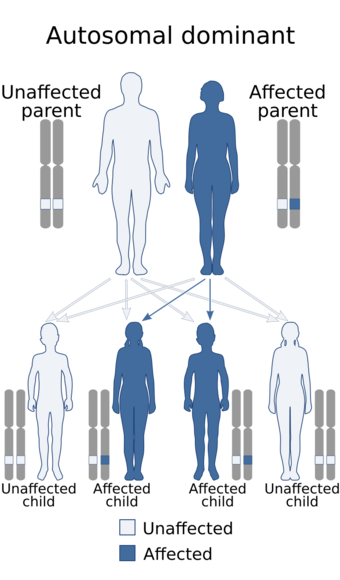Medicine:Czech dysplasia, metatarsal type
| Czech dysplasia, metatarsal type | |
|---|---|
 | |
| This disorder is inherited in an autosomal dominant manner | |
| Specialty | Medical genetics |
| Symptoms | Platyspondyly, foot anomalies, and generalized bone anomalids |
| Complications | Balance (brachymetarsia) |
| Usual onset | Birth |
| Duration | Lifelong |
| Causes | Genetic mutation |
| Risk factors | Being of Czech ancestry. |
| Prevention | none |
| Frequency | rare, only 28 cases have been described in medical literature |
| Deaths | – |
Czech dysplasia metatarsal type is a rare type of Czech dysplasia which is characterized primarily by bone anomalies.
Signs and symptoms
Individuals with this condition start showing symptoms of progressive pseudo-rheumatoid arthritis at a young age, variable congenital vertebral defects, congenital hypoplasia/dysplasia of the third and fourth metatarsal bones.[1][2]
Weather-dependant joint pain is seen occasionally.[3]
Causes
It is caused by a mutation in the COL2A1 gene.
This mutation is called R275C, and it is located in exon 13 of said gene (COL2A1). It is found in most people with Czech dysplasia, metatarsal type.[4]
These mutations are inherited in an autosomal dominant manner, which means that only one copy of a mutated gene (whether inherited or sporadic) is needed for the effects of said mutation to take an effect.
Management
Treatment is done on the symptoms:
- The shortening of the third and fourth metatarsals can be corrected by going through metatarsal lengthening surgery.[5]
- Platyspondyly does not have known effective treatments.[6]
- Pseudo-rheumatoid arthritis can be treated with medication such as nonsteroidal anti-inflammatory drugs, and severe pain sometimes associated with it can be treated with joint arthroplasty.[7]
Prevalence
According to OMIM, 28 cases have been described in medical literature.[8] These cases came from families in Chile ,[9] the Czech Republic,[10][11] Germany ,[12] and Japan .[13]
Eponym
This condition's name (Czech dysplasia) was named after the fact that most families with this condition are from/have ancestry from the Czech Republic.[14]
References
- ↑ "Czech dysplasia metatarsal type - About the Disease - Genetic and Rare Diseases Information Center" (in en). https://rarediseases.info.nih.gov/diseases/10220/czech-dysplasia-metatarsal-type.
- ↑ "Orphanet: Czech dysplasia metatarsal type" (in es). https://www.orpha.net/consor/cgi-bin/Disease_Search.php?lng=ES&data_id=16705&Disease(s)/group%20of%20diseases=Czech-dysplasia--metatarsal-type&title=Czech-dysplasia--metatarsal-type&search=Disease_Search_Simple&ChdId=0.
- ↑ Marik, Ivo; Marikova, Olga; Zemkova, Dana; Kuklik, Miroslav; Kozlowski, Kazimierz (2004-03-01). "Dominantly inherited progressive pseudorheumatoid dysplasia with hypoplastic toes". Skeletal Radiology 33 (3): 157–164. doi:10.1007/s00256-003-0708-z. ISSN 0364-2348. PMID 14730409. https://pubmed.ncbi.nlm.nih.gov/14730409/.
- ↑ Hoornaert, Kristien P.; Marik, Ivo; Kozlowski, Kazimierz; Cole, Trevor; Le Merrer, Martine; Leroy, Jules G.; Coucke, Paul J.; Sillence, David et al. (December 2007). "Czech dysplasia metatarsal type: another type II collagen disorder" (in en). European Journal of Human Genetics 15 (12): 1269–1275. doi:10.1038/sj.ejhg.5201913. ISSN 1476-5438. PMID 17726487.
- ↑ "Brachymetatarsia - Pediatrics - Orthobullets". https://www.orthobullets.com/pediatrics/4082/brachymetatarsia.
- ↑ "platyspondyly | Hereditary Ocular Diseases". https://disorders.eyes.arizona.edu/category/clinical-features/platyspondyly.
- ↑ Bhavani, Gandham SriLakshmi; Shah, Hitesh; Shukla, Anju; Dalal, Ashwin; Girisha, Katta Mohan (1993), Adam, Margaret P.; Mirzaa, Ghayda M.; Pagon, Roberta A. et al., eds., "Progressive Pseudorheumatoid Dysplasia", GeneReviews® (Seattle (WA): University of Washington, Seattle), PMID 26610319, http://www.ncbi.nlm.nih.gov/books/NBK327267/, retrieved 2022-07-07
- ↑ "Entry - #609162 - Czech dysplasia - OMIM" (in en-us). https://omim.org/entry/609162.
- ↑ Williams, C. J.; Considine, E. L.; Knowlton, R. G.; Reginato, A.; Neumann, G.; Harrison, D.; Buxton, P.; Jimenez, S. et al. (November 1993). "Spondyloepiphyseal dysplasia and precocious osteoarthritis in a family with an Arg75-->Cys mutation in the procollagen type II gene (COL2A1)". Human Genetics 92 (5): 499–505. doi:10.1007/BF00216458. ISSN 0340-6717. PMID 8244341. https://pubmed.ncbi.nlm.nih.gov/8244341/.
- ↑ Kozlowski, K.; Marik, I.; Marikova, O.; Zemkova, D.; Kuklik, M. (2004-08-15). "Czech dysplasia metatarsal type". American Journal of Medical Genetics. Part A 129A (1): 87–91. doi:10.1002/ajmg.a.30132. ISSN 1552-4825. PMID 15266623. https://pubmed.ncbi.nlm.nih.gov/15266623/.
- ↑ Marik, Ivo; Marikova, Olga; Zemkova, Dana; Kuklik, Miroslav; Kozlowski, Kazimierz (March 2004). "Dominantly inherited progressive pseudorheumatoid dysplasia with hypoplastic toes". Skeletal Radiology 33 (3): 157–164. doi:10.1007/s00256-003-0708-z. ISSN 0364-2348. PMID 14730409. https://pubmed.ncbi.nlm.nih.gov/14730409/.
- ↑ Tzschach, Andreas; Tinschert, Sigrid; Kaminsky, Elke; Lusga, Eugen; Mundlos, Stefan; Graul-Neumann, Luitgard M. (2008-07-15). "Czech dysplasia: report of a large family and further delineation of the phenotype". American Journal of Medical Genetics. Part A 146A (14): 1859–1864. doi:10.1002/ajmg.a.32389. ISSN 1552-4833. PMID 18553548. https://pubmed.ncbi.nlm.nih.gov/18553548/.
- ↑ Matsui, Yoshito; Michigami, Toshimi; Tachikawa, Kanako; Yamazaki, Miwa; Kawabata, Hidehiko; Nishimura, Gen (October 2009). "Czech dysplasia occurring in a Japanese family". American Journal of Medical Genetics. Part A 149A (10): 2285–2289. doi:10.1002/ajmg.a.33010. ISSN 1552-4833. PMID 19764028. https://pubmed.ncbi.nlm.nih.gov/19764028/.
- ↑ "Czech dysplasia: MedlinePlus Genetics" (in en). https://medlineplus.gov/genetics/condition/czech-dysplasia/.
 |

